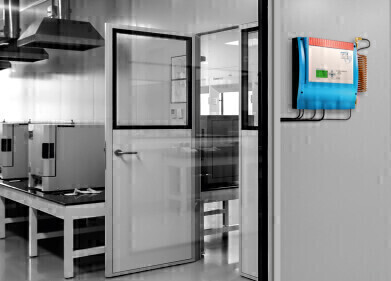Fixed gas monitor
‘World’s first’ TAC fixedphotoionisation detector
Feb 18 2019
Ion Science has launched its ‘world first’ FalcoTAC fixed photoionisation detector (PID) with 10.0eV lamp for fast and reliable detection of highly toxic total aromatic compounds (TACs), including benzene, in high humidity environments. Designed for plant-wide safety and the on-going protection of workers in global petrochemical and oil & gas applications, the new FalcoTAC instrument also boasts the company’s innovative typhoon technology for unrivalled accuracy in condensing atmospheres and extreme weather conditions.
Aromatic chemical compounds produced by oil refineries and petrochemical plants form the building blocks for numerous important materials including dyes, detergents, solvents, adhesives, plastics, synthetic rubbers and pharmaceuticals. However the TACs produced in these environments such as benzene, toluene and xylene isomers, are also highly toxic.
Utilising the proprietary high output Ion Science 10.0 electron volt (eV) detection system, the new FalcoTAC volatile organic compound (VOC) monitor offers fast response times and the best possible protection for plant personnel, giving early warning of any harmful levels of exposure to hazardous TACs, including benzene.
Simple to install and operate, the FalcoTAC features an external intrinsically safe sensor for quick and easy servicing without the need for a hot work permit, and can be serviced and calibrated in a hazardous environment without having to remove the power.
Ion Science’s advanced typhoon technology prevents condensation forming on the sensor which helps to stop the FalcoTAC short circuiting and make it ideal for harsh conditions and wet outdoor environments, without the need for weather enclosures.
By incorporating Ion Science’s market-leading PID sensor and patented fence electrode technology, FalcoTAC does not experience quenching of response due to humidity in the ambient air. This increased resistance to humidity and contamination ensures ultimate reliability in the field, as well as considerably reduced drift issues and extended run time.
FalcoTAC is operated via an intuitive user interface with OLED display and five magnetically activated switches – up, down, left, right and enter – which are back lit to help confirm the correct button is being pressed. For added convenience, safety and ease of use, brightly coloured red, amber and pulsing (optional) green status indicators are clearly visible in sunlight allowing checks to be conducted from a distance.
The FalcoTAC utilises a diffusive sample technique which ensures less contamination issues than pumped systems and reduced lamp cleaning and servicing requirements. Pumped models are available for applications where a sample needs to be drawn to the unit.
The FalcoTAC 10.0eV is available offering a detection range of 0.01 – 50 parts per million (ppm).
The explosion proof enclosure is certified to EX d IIC T4 II and the external sensor to EX ib IIC T4 Gb II. A 4 – 20 mA analogue output enables FalcoTAC to be easily integrated into a DCS control system to give warning or control of high VOC levels in the working environment. Two relay outputs means it can be connected remotely plus RS485 output with Mobus protocol included as standard allows the instrument to be connected to a network.
Digital Edition
PIN 26.1 Feb/Mar 2025
March 2025
Analytical Instrumentation - Elemental Analysis for Quality and Process Control at Refineries, for Lubricants and Wear Metals in Engine Oils - Synthetic Lubricants: New Developments - Scaling...
View all digital editions
Events
Apr 08 2025 Birmingham, UK
Apr 08 2025 Kielce, Poland
Apr 08 2025 Ravenna, Italy
Apr 08 2025 Southampton, UK
Apr 08 2025 London, UK



















